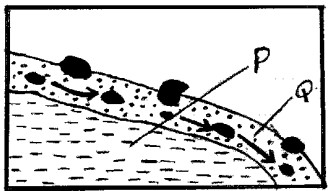Question 1
- What is physical environment?
- Identify three areas of study under physical geography.
Answer
- External surrounding which is made up of the features that are not created by human beings a though their presence may have been influenced by human activities
- - The earth and the solar system
- The internal land forming processes
- The external land forming processes
- Weather and climate
- Soil and vegetation
Question 2
- Differentiate between extensional boundary and compressional boundary.
- Briefly describe the continental drifting theory.
Answer
- Extension boundaries is one where the tectonic plates are moving away from each other while compressional boundary is one where plates move towards each other.
- - States that the earth was initially one liquid mass called pangea.
- It was surrounded by a great ocean called panthalasa whose floor was mainly dima layer.
- During the late Precambrian period, Pangaea broke up into two blocks gurasia and godwana land
- They were separated by a narrow ocean called Tethya.
- During Mesozoic era, Laurasia broke up into two; Laurentaian shield and Fennoscandia
- Godwana land broke up into blocks, namely Africa Australia, the Americans, Australia and the Indian dubeunlinents, Africa and India drifted northwards while Australia drafted eastwards. The Americas drafted westwards.
Question 3
- What is natural vegetation?
- State three characteristics of Mediterranean type of vegetation.
Answer
- Plant cover growing widely on its own without man’s influence.
- - The vegetation is adopted to the long and dry summer.
- Some plants are ever green.
- Grasses dry up during summer and germinate during winter.
- Scrubs, thickets, bush and thorn bush and maquis are common.
- Woody scrub is common in very dry areas.
- Some plants have small, spiny leaves while others have thick skinned or leathery leaves.
- Some plants have long roots.
- Some plants thick barks
- Some plants large and fleshy bulbous roots
- Some plants have fleshy leaves while others, have shiny, waxy leaves.
- Some plants are deciduous.
Question 4
- What is a seismic zone?
- State two ways in which people have responded to the occurrence of earthquakes.
Answer
- This is a zone that is prone to earth quakes.
- - Evacuation of people from earthquake prone areas.
- Research on the prediction of earthquakes.
- High technology on the prediction of earthquakes.
- Introduction stricter building codes
Question 5
- State two conditions which influence the occurrence of landslides.
-

Using the diagram above, name:
- The type of mass movement shown
- The features marked P and Q
Answer
- 1. Heavy rainfall resulting to lubrication by the rainwater facilitate the movement of the materials.
2. Tectonic movements – earthquakes and volcanic eruptions cause vibrations of the earth which often trigger off landslides.
3. The angle of slope – the steeper the slopes, the faster the movement - Solifluction
- P - frozen sub – soil Q - saturated top soil
